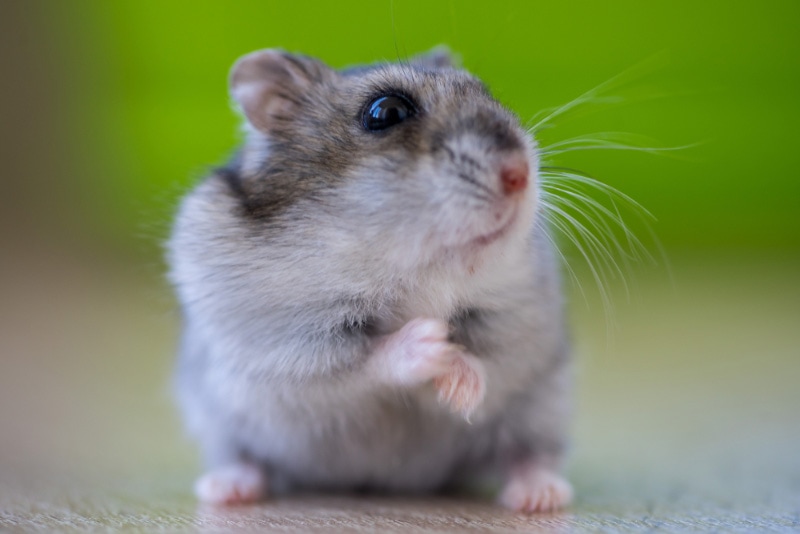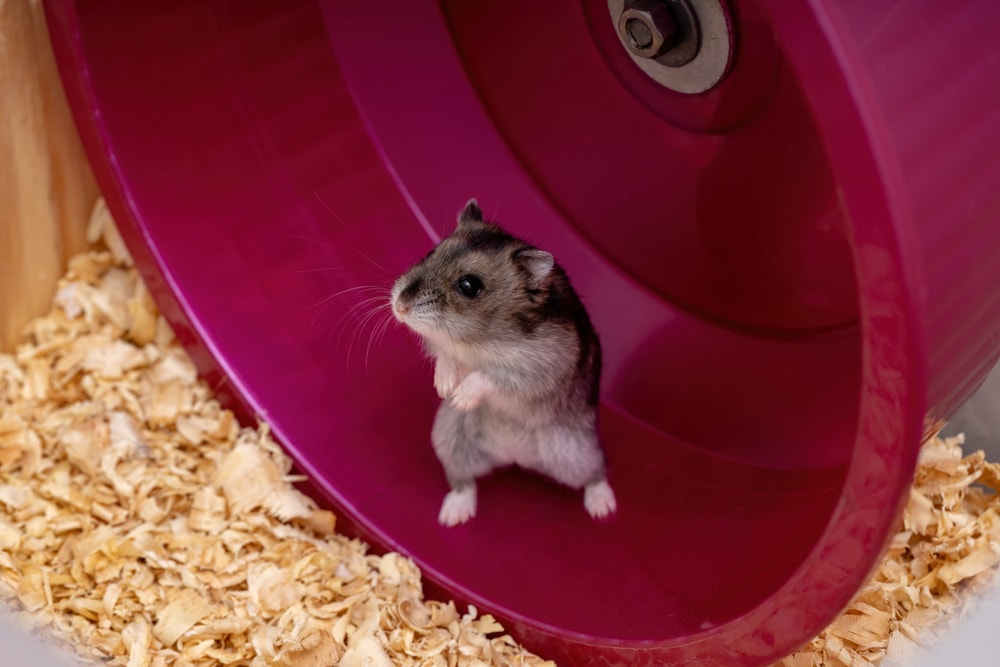Syrian Hamster: Pictures, Temperament & Traits

Updated on
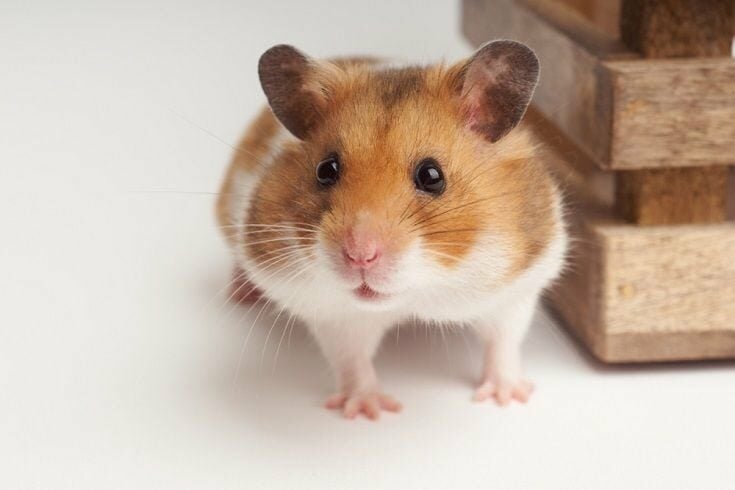
Click to Skip Ahead
Syrian hamsters are one of the most popular choices for small pets. They’re so cute they’re also known as Golden or Teddy Bear hamsters. If you’re thinking about getting one, you might wonder what goes into their care so you can decide if they’re suitable for your family. Syrian hamsters are relatively low-maintenance pets, easy to tame, and ideal for beginners. So, let’s take a closer look at what that means.
| Size: | 5 – 9 inches |
| Weight: | 4 – 7 ounces |
| Lifespan: | 2 – 4 years |
| Similar Breeds: | Chinese hamster, Dwarf hamster, Winter White Dwarf hamster |
| Suitable for: | Beginners |
| Temperament: | Curious, docile with humans, solitary, easy to tame, comfortable being handled |
The Syrian hamster comes from arid regions of Southern Turkey and Northern Syria. They are generally golden brown with a lighter belly; however, thanks to selective breeding, they can also come in other hair lengths, patterns, and colors. While they aren’t big pets, that doesn’t mean they’re not full of personality. Syrian hamsters are known for developing quirky personalities and quirks that are entirely their own.
Syrian Hamster Characteristics
How Much Do These Hamsters Cost?
Syrian hamsters generally cost between $5 and $25 depending on their hair length, color variations, and whether you decide to adopt or shop. Hamsters from reputable breeders can cost around $70, but you will come away with more than just a hamster in those cases. For example, many reputable breeders will tame the hamster to be handled and give you a start-up kit to make the transition smoother.
When buying a hamster, it’s important to choose where to acquire one wisely as you don’t want to inadvertently support a rodent mill, where hamsters are mass-produced for profit in poor conditions, generally without access to medical treatment or proper care.
When taking on a hamster, you must factor in everything you need to care for them in your initial costs. Hamsters need proper housing, toys, and food, which can all be quite costly at the beginning.
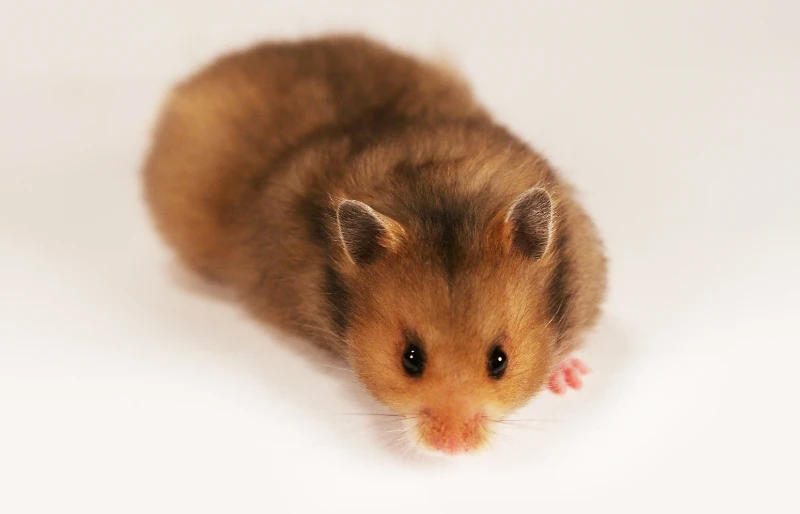
Temperament & Intelligence of the Syrian Hamster
If you have had any experience with hamsters, the Syrian hamster won’t surprise you much as they’re very similar to other breeds. They’re nocturnal, so they sleep for more of the day, which means they’re at their loudest at night. It’s therefore important to consider carefully where you choose to house them.
Certain hamsters might adapt to their owner’s schedule, but you shouldn’t rely on this happening. You should also avoid picking up a sleeping hamster as they could bite you when startled or mishandled.
Syrian hamsters are relatively smart and enjoy moving around in tubes in their enclosures. They create a bathroom at a point far from where they sleep, making it simpler for you when it is time to clean them out.
Do These Hamsters Make Good Pets?
Many parents get a Syrian hamster as a first pet for their children as they’re so docile with humans and are easy to look after. They’re also good for teaching children responsibility and traits like compassion, patience, and being gentle. However, as hamsters do sleep mainly during the day, consider that sometimes your hamster will wake up as your child goes to bed.
Syrian hamsters are also not like a dog in the sense they bond closely with their owners. They’ll usually come to the side of the enclosure you’re standing at and run around your lap, but you won’t get as much back from them as you would, for example, from a cat or dog.
Additionally, make sure you’re taking time to handle your hamster each day to ensure they stay tame.
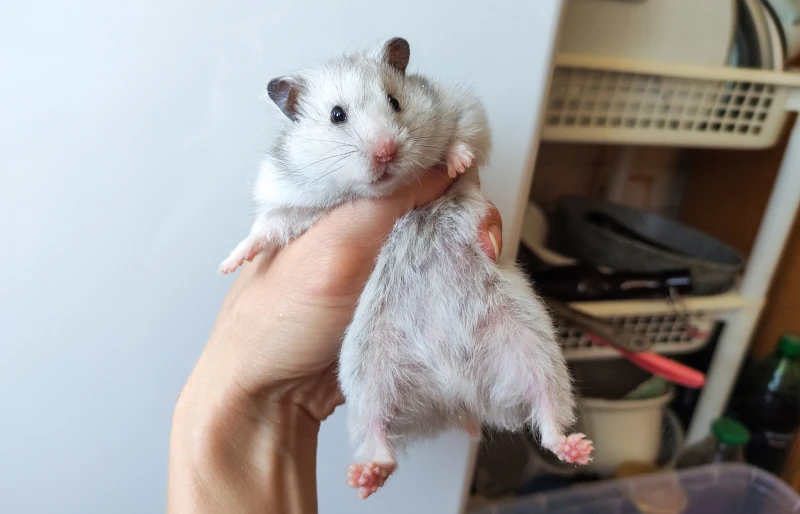
Does This Hamster Get Along With Other Pets?
These hamsters are incredibly solitary, territorial animals. They should be housed alone, so if you breed them, you must separate them before they reach maturity. If you fail to separate your Syrian hamsters, they can fight so severely that one kills the other. Regarding other pets in the house, hamsters are natural prey animals and are skittish, so they should be kept separate to avoid stressing them out or causing injury.
Things to Know When Owning a Syrian Hamster:
Hamsters don’t have a particularly long lifespan, but that doesn’t mean there are not things you can do to ensure they live as long and healthy a life as possible.
Food & Diet Requirements

As omnivores, Syrian hamsters will eat a mix of cereals, seeds, insect larvae, and larger insects like crickets in the wild. As a pet, they need a balanced, high-quality, and varied diet containing all the minerals and nutrients required to thrive. They can get this from:
- A mixture of different seeds or compound pellet ration
- Small quantities of fruit like apples, greens, and clean root vegetables. Avoid rhubarb and grapes, as they can be poisonous.
- They can enjoy grains, seeds, and nuts as a treat occasionally.
- Add a feeder insect or hardboiled egg as a protein boost occasionally.
A teaspoon of food daily should be enough for your hamster; it might not seem like a lot, but remember, they are small pets. Overfeeding your hamster can cause health problems like obesity.
Enclosure Requirements
A big mistake many first-time owners make is getting an enclosure that isn’t big enough. At a minimum, you want something around 1’ x 2’ x 1’, but a larger cage can hold more of their accessories and provide more running space.
They will need a sleeping hut or nest in the corner, which you can get from a pet store. If you’re getting an exercise wheel, the solid ones minimize the risk of injury compared to the wire ones. You can also get wooden chew blocks for their dental hygiene and tunnels and bridges for climbing and hiding.
As for substrate, they will need a couple of inches of bedding, either from aspen or paper products. Avoid cedar or pine since the strong smell can harm their lungs, and the sharp pieces can cut them. You will have to scoop out wet spots daily, change the bedding weekly, and scrub the enclosure with soap and water.
A good option for your hamster while you do this is a hamster ball so they can run around and exercise. Monitor them as they might get stuck behind furniture, and ensure the stairs are blocked off if you’re upstairs.
Exercise & Sleeping Needs
If you provide your hamster with an exercise wheel and enough space to roam around, they should get plenty of exercise. They must exercise daily because it will prevent health issues such as obesity.
Your hamster generally sleeps 12–14 hours a day, but hamsters also have polyphasic sleep-wake patterns, which means that these 12–14 hours of sleep will be broken up throughout the day. As nocturnal animals, they sleep during the day and are awake at night.
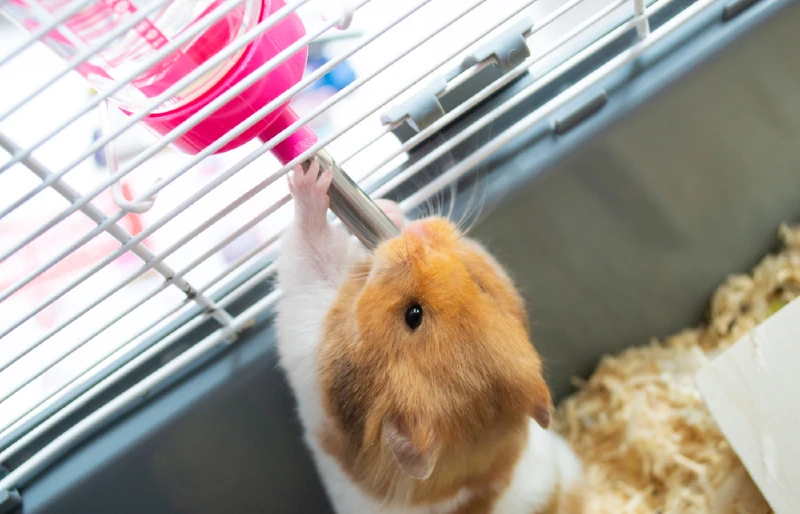
Training
You don’t have to train your hamster, but they can be taught a few simple tricks. For example, if you call your hamster by its name regularly, they can learn to recognize it. Hamsters can also be litter-trained.
Grooming
Hamsters are pretty low maintenance when grooming, as they tend to groom themselves. If you own the long-haired version, you might have to give them a short weekly brush to remove food, substrate, and dirt from their coat. You can use a small animal comb or even a fine, soft toothbrush.
A hamster’s teeth never stop growing, so they will need a chew stick, toy, or mineral chew to wear them down. Contact your veterinarian if you notice chipped or broken teeth or if they become overgrown.
Hamsters don’t tend to need their claws trimmed, but if you notice them scratching themselves when grooming or that the nails are curled beneath their feet, take them to the veterinarian.
Lifespan and Health Conditions
Syrian hamsters live for around 4 years at the most, but on average, tend to live around 3 years, which is standard for a hamster. There are some health conditions you will need to watch out for. You need to examine your pet for fur and ear mites; thankfully, they’re easy to treat. Generally, your vet will provide a topical treatment, shampoo, or dust. To prevent it from happening, use sterile bedding and change it regularly.
They can develop a wet tail, which is a bacterial infection affecting the GI tract that causes soft droppings and diarrhea. Your hamster will need a course of antibiotics from the vet to treat it.
As your hamster ages, they are more at risk of developing tumors. Watch for sudden bumps and lumps, and contact your vet immediately. Some other problems can also arise with improper care, such as obesity.
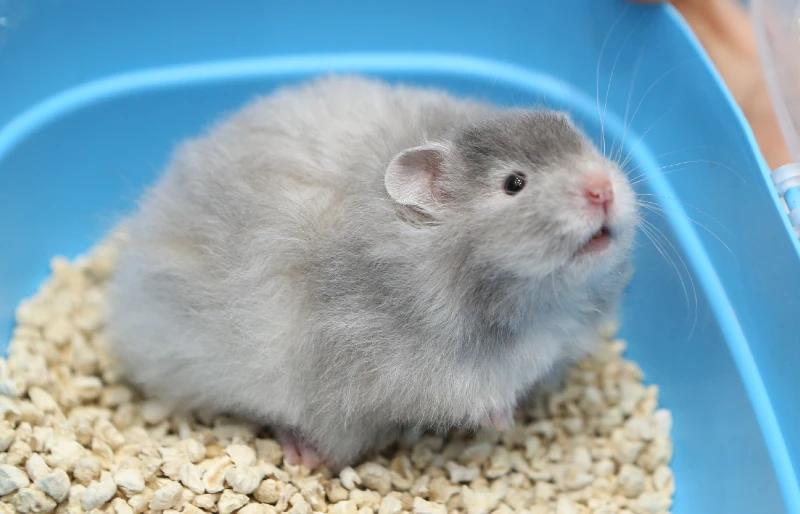
- Mites
- Obesity
- Cheek pouch impaction
- Wet tail
- Tumors
Male vs Female
Male Syrian hamsters are generally calmer than their feistier female counterparts. They are also smaller than the females. Additionally, females will be in “mating season” every 4 days or so for a few hours. While in heat, she will give off a potent and musky odor.
3 Little-Known Facts About Syrian Hamsters
1. They Can Go Into False Hibernation
If the temperature dips below 40 ̊F, Syrian hamsters have been known to go into false hibernation. This means they might look asleep or even dead. If you suspect this has happened, gradually raise the temperature, and your hamster should wake again.
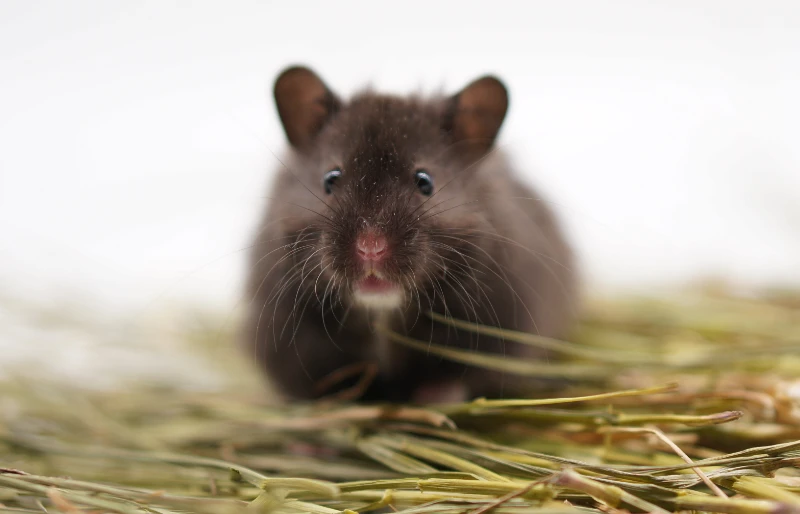
2. They Have Flexible Cheek Pouches
Syrian hamsters have flexible cheek pouches used after foraging to carry food to their burrows. They are so flexible they expand to their shoulders, which has earned them a name in Arabic that translates to “mister saddlebags.”
3. They Can All Be Traced Back to One Mother
In 1930, outside of Aleppo, Syria, the Jewish biologist Israel Aharoni captured a female hamster and 12 of her pups. Eventually, they began to breed after a rough start, and now all Syrian hamsters can be traced back to this captured female.
Final Thoughts
Syrian hamsters are wonderful pets, are docile with humans, like being handled, and are smart enough to learn simple tricks. They are territorial and natural prey animals, so they shouldn’t share their space with any other pets, and if you have other larger pets, make sure you keep them separate. Syrian hamsters are nocturnal and relatively easy to take care of. They rarely bite but will if startled or scared.
Featured Image Credit: Johannes-Menge, Shutterstock

